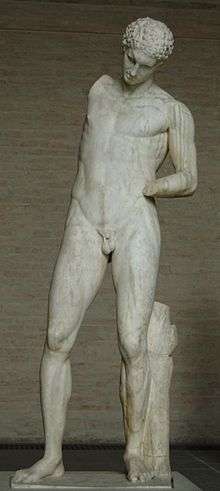Oil Pourer

The Oil Pourer is a lost Greek bronze of an athlete variously associated with the circle of Lysippos, c. 340-330 BCE, of which Roman marble copies exist, notably in the Glyptothek, Munich (illustration)[1] and in the Albertinum, Dresden.[2] Another well-known Roman replica is conserved at Petworth House.[3] There is a head of this type at the Boston Museum of Fine Arts.[4] The Oil Pourer is similar in proportions and manner to the Lysippean Agias of which there is a Roman marble copy at Delphi.[5]
The athlete is represented pouring oil from a flask held high in his (missing) right hand into the (missing) palm of his left. The theme is represented on Attic vase-painting[6] and in freely reinterpreted cast terracotta miniatures.[7]
The Munich sculpture was treated in the 19th century with acid to clean it, which has dissolved about 2mm off its surfaces.
Notes
- ↑ Acc. no. 302.
- ↑ Acc. no. 67.
- ↑ Reckoned a "Polycleitan" adaptation of an Attic model such as the original of the Munich copy, in Adolf Furtwängler, Meisterwerke der griechischen Plastik (Leipzig/Berlin) 1893:465 (p.257 in the English translation)
- ↑ Acc. no. 04.11; illustrations
- ↑ A. F. Stewart, "Lysippan Studies 2. Agias and Oilpourer", American Journal of Archaeology 82.3 (Summer 1978:301-313).
- ↑ Furtwängler illustrates
- ↑ "Typically coroplasts eschewed accurate replicas for new creations couched in the stylistic vocabulary of an influential sculptor such as Polykleitos or Praxiteles", observes Elizabeth Bartman, Ancient Sculptural Copies in Miniature (Leiden:Brill, 1992) "Statuary types and materials" p. 21 and note 31: "To this category belong variants of the Munich Oil Pourer".